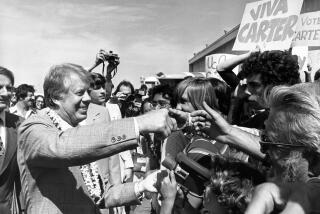Political Buttons Toss a Hat in the Ring
- Share via
Presidential nominating convention week translated into a flood of political buttons last month in Atlanta, where the Democrats held their shindig. New Orleans, where Republicans will convene next week, also should be awash with pins of every description and hue.
But before you begin acquiring these buttons for collecting purposes, keep in mind that the pins are worth only what you paid for them and won’t have any real collectible value for another decade or two--if then--according to veteran collectors.
A Dealer-Collector
One such expert is Ted Hake of York, Pa., a dealer-collector who’s been writing on the subject for a number of years.
“I prefer to let 10 or 15 years pass by to see what people are really looking for,” Hake said in a telephone interview.
Hake said collectors might be better off looking for buttons tied to a particular locality or a local candidate rather than run-of-the-mill pins showing a lone picture of a would-be President.
For example, he said, if a button shows a presidential or vice presidential candidate tied to a particular geographic region, or linked to a candidate for local office, appreciation could occur faster than a button displaying the candidate by himself.
How many years does the serious collector of presidential buttons have to wait before they show appreciation? Hake said that, as a rule of thumb, today’s collectors generally have to go back to the 1964 Lyndon B. Johnson-Barry Goldwater race before they can run across buttons with some real value.
Among favorites with collectors, he said, are those featuring presidents who had big national followings, such as Theodore Roosevelt, Franklin Delano Roosevelt and Harry S. Truman.
In the “loser” category, collectors have made three-time presidential candidate William Jennings Bryan among the most popular in terms of button collecting, Hake said. One reason is that the first year Bryan ran--1896--was the same year that pin-back political buttons were first introduced. These are buttons with a celluloid front and a pin on the back.
Determining Value
Supply and demand still count for a lot in determining the value of political buttons, Hake underscored. For example, he said, some Bryan buttons and those of his opponent, William McKinley, were made in such large quantities that they can still be bought for $10 apiece, he said.
But a button showing McKinley and his 1896 vice presidential running mate, Garret Hobart, can go for $1,000, he said, if you can find one for sale. This button shows McKinley and Hobart riding a tandem to the White House door.
The same limited-supply factor applies to a political button generated by the 1920 White House race. That year, the Republican ticket of Warren G. Harding and Calvin Coolidge defeated James M. Cox and a young FDR.
“The Democratic Party was broke that year, so they didn’t distribute a lot of buttons,” Hake said. Hence, Cox-FDR buttons are now worth a small fortune, one having sold for about $30,000 five years ago.
Hake cautions the collector to stick to buttons that actually were produced for political conventions and attending delegates, rather than those that are mass-produced for collectors.
“Nowadays, the game is to make as many varieties as you can,” he said. The problem is that the value of mass-produced buttons is oftentimes negligible.
Also, buttons associated with a candidate can, for whatever reasons, drop in price.
This happened with Jimmy Carter buttons, which at one time were selling for $15 each, Hake said. Now, he added, “they’re down to $1.” Hake attributes the initial high price to “collector fever” following the 1976 Democratic convention, which nominated Carter.
To network with individuals who can give fledgling collectors tips on what to look for, there is a national group called American Political Items Collectors, P.O. Box 340339, San Antonio, Tex. 78234.
More information is available from Hake, who has written a set of three volumes on collecting presidential campaign items, featuring more than 12,000 campaign citations. In addition, his 100th mail-order auction catalogue, scheduled for publication by mid-August, can be obtained for $3 from Hake’s Americana & Collectibles, P.O. 1444, York, Pa. 17405.
Soble cannot answer mail personally but will respond in this column to questions of general interest about collectibles. Do not telephone. Write to Your Collectibles, You section, The Times, Times Mirror Square, Los Angeles 90053.
More to Read
Sign up for Essential California
The most important California stories and recommendations in your inbox every morning.
You may occasionally receive promotional content from the Los Angeles Times.













